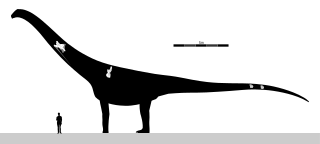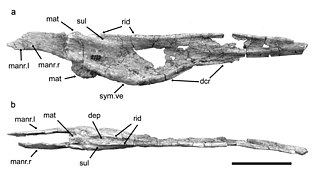
Argentinosaurus is a genus of giant sauropod dinosaur that lived during the Late Cretaceous period in what is now Argentina. Although it is only known from fragmentary remains, Argentinosaurus is one of the largest known land animals of all time, perhaps the largest, measuring 30–35 metres (98–115 ft) long and weighing 65–80 tonnes. It was a member of Titanosauria, the dominant group of sauropods during the Cretaceous. It is widely regarded by many paleontologists as the biggest dinosaur ever, and perhaps lengthwise the longest animal ever, though both claims have no concrete evidence yet.

Titanosaurs were a diverse group of sauropod dinosaurs, including genera from all seven continents. The titanosaurs were the last surviving group of long-necked sauropods, with taxa still thriving at the time of the extinction event at the end of the Cretaceous. This group includes some of the largest land animals known to have ever existed, such as Patagotitan—estimated at 37 m (121 ft) long with a weight of 69 tonnes —and the comparably-sized Argentinosaurus and Puertasaurus from the same region.

Antarctosaurus is a genus of titanosaurian sauropod dinosaur from the Late Cretaceous Period of what is now South America. The type species, Antarctosaurus wichmannianus, and a second species, Antarctosaurus giganteus, were described by prolific German paleontologist Friedrich von Huene in 1929. Three additional species of Antarctosaurus have been named since then but later studies have considered them dubious or unlikely to pertain to the genus.

Aeolosaurus is a genus of titanosaurian sauropod dinosaur from the Late Cretaceous Period of what is now South America. Like most sauropods, it would have been a quadrupedal herbivore with a long neck and tail. Aeolosaurus is well known for a titanosaur, as it is represented by the remains of several individuals belonging to at least two species. However, like most titanosaurs, no remains of the skull are known. The holotype of Aeolosaurus rionegrinus consists of a series of seven tail vertebrae, as well as parts of both forelimbs and the right hindlimb. It was discovered in the Angostura Colorada Formation in Argentina, which dates from the Campanian stage of the Late Cretaceous, about 83 to 74 million years ago. The species A. maximus was transferred over to the new genus Arrudatitan in 2021.

Bonitasaura is a genus of titanosaurian dinosaur hailing from uppermost layers of the Late Cretaceous (Santonian) Bajo de la Carpa Formation, Neuquén Group of the eastern Neuquén Basin, located in Río Negro Province, Northwestern Patagonia, Argentina. The remains, consisting of a partial sub-adult skeleton jumbled in a small area of fluvial sandstone, including a lower jaw with teeth, a partial vertebrae series, and limb bones, were described by Sebastian Apesteguía in 2004.

Futalognkosaurus is a genus of titanosaurian dinosaur. The herbivorous Futalognkosaurus lived approximately 87 million years ago in the Portezuelo Formation, in what is now Argentina, of the Coniacian stage of the late Cretaceous Period. The fish and fossilized leaf debris on the site, together with other dinosaur remains, suggest a warm tropical climate in Patagonia during this period.
Mendozasaurus is a genus of titanosaurian sauropod dinosaur. It was a member of Titanosauria, which were massive sauropods that were common on the southern landmasses during the Cretaceous. It is represented by several partial skeletons from a single locality within the Coniacian Sierra Barrosa Formation in the south of Mendoza Province, northern Neuquén Basin, Argentina. The type species, Mendozasaurus neguyelap, was described by Argentine paleontologist Bernardo Javier González Riga in 2003. Mendozasaurus is the first dinosaur named from Mendoza Province, Argentina, for which it was named.
The Plottier Formation is a geologic formation that outcrops in the Argentine Patagonian provinces of Río Negro and Neuquén. It is the younger of two formations belonging to the Río Neuquén Subgroup within the Neuquén Group of the Neuquén Basin, with the oldest rocks dating from the late Coniacian and its youngest maybe from the very start of the Santonian. Formerly, that subgroup was treated as a formation, and the Plottier Formation was known as the Plottier Member.

Rinconsaurus is a genus of titanosaur sauropod dinosaur from the Late Cretaceous in what is now Argentina. The type species, Rinconsaurus caudamirus, was described by Calvo and Riga in 2003, and is based on three partial skeletons.

Puertasaurus is a genus of sauropod dinosaur that lived in South America during the Late Cretaceous Period. It is known from a single specimen recovered from sedimentary rocks of the Cerro Fortaleza Formation in southwestern Patagonia, Argentina, which probably is Campanian or Maastrichtian in age. The only species is Puertasaurus reuili. Described by the paleontologist Fernando Novas and colleagues in 2005, it was named in honor of Pablo Puerta and Santiago Reuil, who discovered and prepared the specimen. It consists of four well-preserved vertebrae, including one cervical, one dorsal, and two caudal vertebrae. Puertasaurus is a member of Titanosauria, the dominant group of sauropods during the Cretaceous.

Lithostrotia is a clade of derived titanosaur sauropods that lived during the Early Cretaceous and Late Cretaceous. The group was defined by Upchurch et al. in 2004 as the most recent common ancestor of Malawisaurus and Saltasaurus and all the descendants of that ancestor. Lithostrotia is derived from the Ancient Greek lithostros, meaning "inlaid with stones", referring to the fact that many known lithostrotians are preserved with osteoderms. However, osteoderms are not a distinguishing feature of the group, as the two noted by Unchurch et al. include caudal vertebrae with strongly concave front faces (procoely), although the farthest vertebrae are not procoelous.

Macrogryphosaurus is a genus of elasmarian dinosaur from the Coniacian age Upper Cretaceous Sierra Barrosa Formation of Argentina in Patagonia. It was described by Jorge Calvo and colleagues in 2007, with M. gondwanicus as the type and only species.

Lognkosauria is a clade of giant long-necked sauropod dinosaurs within the clade Titanosauria. It includes some of the largest and heaviest dinosaurs known. They lived in South America and likely Asia during the Late Cretaceous period.
Traukutitan is a genus of titanosaur sauropod dinosaur which lived during the late Cretaceous.

Jorge Orlando Calvo was an Argentine geologist and paleontologist working for "Centro de Investigaciones Paleontológicas Lago Barreales".

Elasmaria is a clade of ornithopods known from Cretaceous deposits in South America, Antarctica, and Australia that contains many bipedal ornithopods that were previously considered "hypsilophodonts".

Notocolossus is a genus of titanosaurian sauropod dinosaur from late Cretaceous strata of Mendoza Province, Argentina.

Rinconsauria is an extinct clade of giant titanosaurian sauropods known from the late Cretaceous period of Argentina.

Argentinadraco is an extinct genus of azhdarchoid pterosaur from the Late Cretaceous Portezuelo Formation of Argentina. It contains a single species, A. barrealensis, named in 2017 by Alexander Kellner and Jorge Calvo. Argentinadraco is unusual for bearing a bottom jaw with a concave bottom edge, as well as a pair of ridges and depressions on the top surface. These features distinguish it from all other azhdarchoid groups, complicating its assignment, but it may belong to the Chaoyangopteridae. The ridges on the lower jaw may have been used to feed on small invertebrates in loose sediment within the system of lakes and rivers that it resided in.
The Sierra Barrosa Formation is a geologic formation of the Neuquén Basin in the northern Patagonian provinces of Mendoza and Neuquén. The formation dates to the Late Cretaceous, middle to late Coniacian, and belongs to the Río Neuquén Subgroup of the Neuquén Group. The formation overlies the Los Bastos Formation and is overlain by the Plottier Formation. As the underlying Los Bastos Formation, the Sierra Barrosa Formation comprises mudstones and sandstones deposited in a fluvial environment.

























